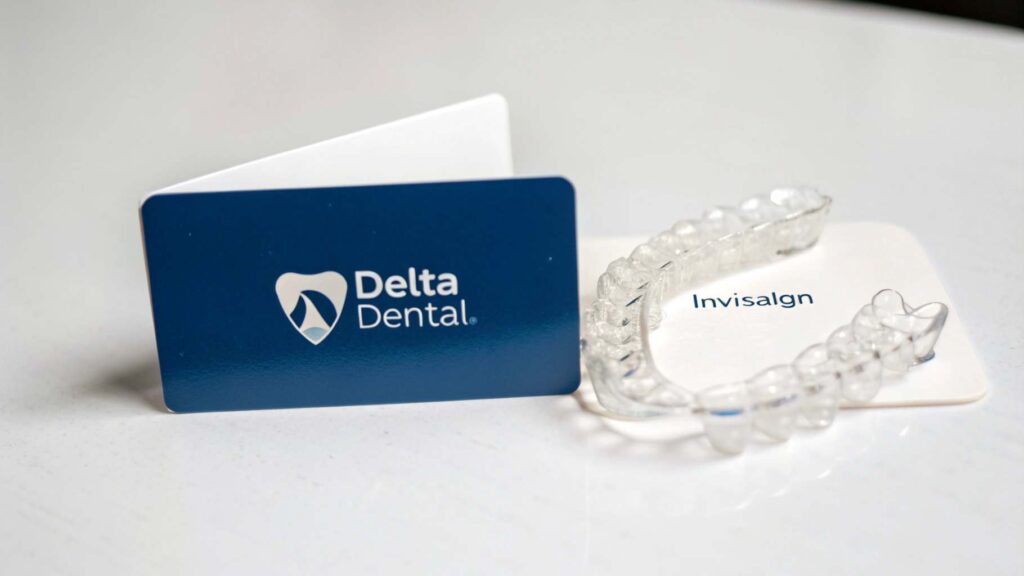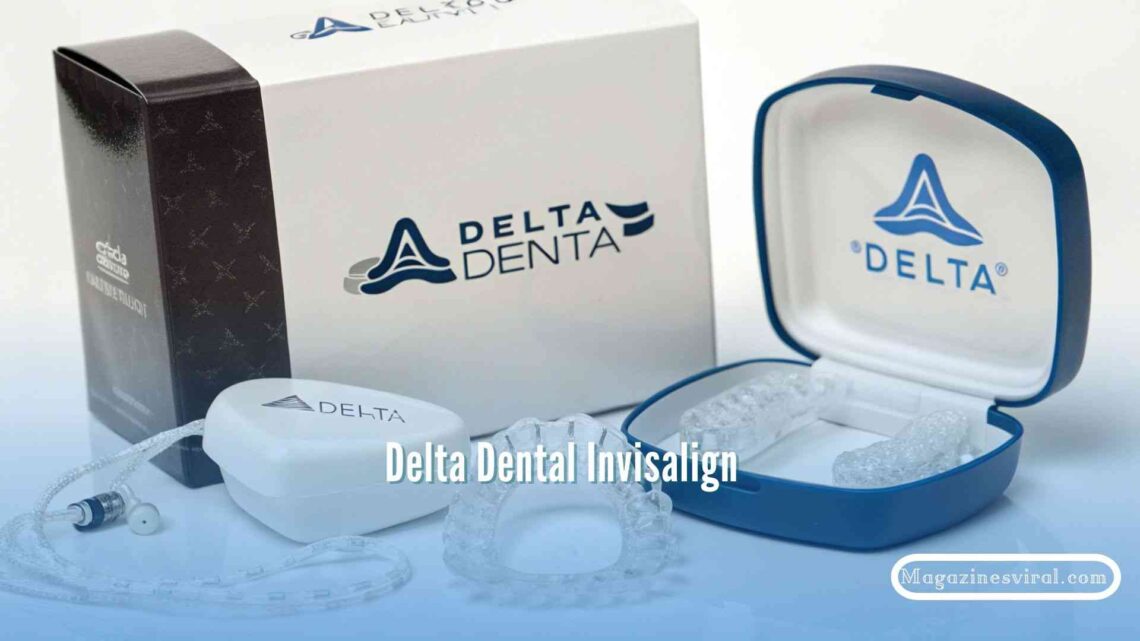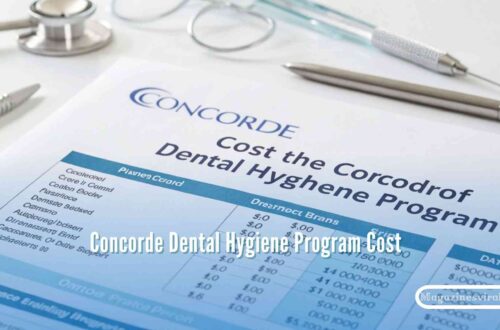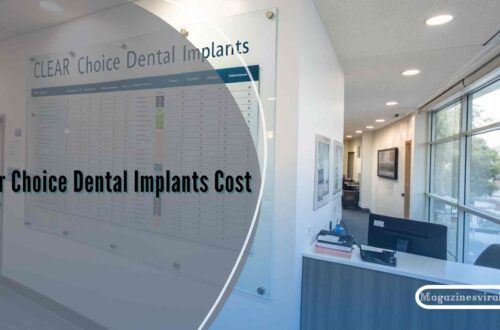Delta Dental Invisalign helps cover the cost of clear aligners for a straighter smile. Check your plan to see what’s included and how much you can save.
Stay tuned with us as we share all the important details about Delta Dental Invisalign. We’ll talk about everything you need to know, from coverage to costs, so you can make the best decision for your smile!
What Is Invisalign?
Invisalign is a modern alternative to metal braces. Instead of brackets and wires, you wear a series of custom-made, clear aligners that shift your teeth into place over time. They’re nearly invisible, comfortable, and removable.
Key Benefits of Invisalign:
- Transparent and discreet
- Removable for eating, brushing, and flossing
- Fewer office visits than traditional braces
- No dietary restrictions
- Typically shorter treatment time (6–18 months)
Does Delta Dental Cover Invisalign?

Yes, but it depends on your plan.
Delta Dental does offer orthodontic benefits, and many of its plans include Invisalign—especially those that consider Invisalign equivalent to traditional braces. However, not all plans cover it the same way.
Coverage Depends On:
- Type of Delta Dental plan (PPO, Premier, DeltaCare USA)
- Whether orthodontics is included
- Age restrictions
- Whether your provider is in-network
- Cosmetic vs. medically necessary treatment
Types of Delta Dental Plans That May Cover Invisalign
Here’s how Invisalign is typically handled in Delta Dental’s main insurance products:
| Plan Type | Invisalign Coverage | Notes |
| Delta Dental PPO™ | Often covers 25%–50% | Most flexibility; higher lifetime max |
| Delta Dental Premier® | Often covers 25%–50% | Broader network, may cost slightly more |
| DeltaCare® USA | Varies widely | Often requires a referral or approval |
Always read your Summary of Benefits to confirm.
Regional Cost Variations for Invisalign With Delta Dental
The cost of Invisalign can vary significantly by state and even by city. Here’s a snapshot of average Invisalign pricing across the U.S. in 2025:
| Region | Without Insurance | With Delta Dental (50% coverage) |
| California | $5,500 – $7,500 | $2,750 – $3,750 |
| Texas | $4,500 – $6,000 | $2,250 – $3,000 |
| New York | $5,800 – $7,800 | $2,900 – $3,900 |
| Florida | $4,000 – $6,500 | $2,000 – $3,250 |
| Midwest (e.g., Ohio, IL) | $3,800 – $5,500 | $1,900 – $2,750 |
Pro Tip: Urban areas tend to have higher prices, but also more Invisalign providers—giving you leverage to compare quotes.
How Much Will Invisalign Cost With Delta Dental?
On average, Delta Dental covers 25% to 50% of the Invisalign treatment cost, up to a lifetime orthodontic maximum—often between $1,000 and $2,500.
Sample Cost Scenario:
- Total Invisalign cost: $6,000
- Delta Dental covers 50% up to $2,000 max
- You pay: $4,000 out-of-pocket
Keep in mind:
- Annual deductibles may apply
- Waiting periods of 6–12 months are common
- Only in-network providers may be covered
What If Invisalign Is Considered Cosmetic?
Some Delta Dental plans exclude cosmetic treatments, and Invisalign might fall under this category—especially if you’re an adult seeking minor alignment improvements. However, if your provider documents that Invisalign is medically necessary (e.g., correcting bite issues or preventing jaw disorders), you may still get partial coverage.
Pediatric vs. Adult Invisalign Coverage With Delta Dental
Age matters when it comes to Delta Dental Invisalign coverage:
For Children (Typically Under 19):
- Orthodontic coverage is more common
- Invisalign may be covered just like braces
- No cosmetic exclusion usually applies
For Adults:
- Orthodontic coverage is less common
- Invisalign may be labeled as cosmetic
- Lower lifetime max and stricter limits
How to Check If Your Delta Dental Plan Covers Invisalign?
Here’s how to find out exactly what your plan covers:
Option 1: Through Your Online Portal
- Visit (DeltaDental.com)
- Log into your account
- Navigate to Benefits > Summary of Benefits
- Look for “Orthodontic Treatment” and “Invisalign” keywords
Option 2: Ask Delta Dental Support
Call the number on your ID card and ask:
- “Does my plan cover orthodontics?”
- “Is Invisalign covered the same as braces?”
- “What is my lifetime orthodontic maximum?”
- “Is there a waiting period?”
Option 3: Ask Your Orthodontist to Check for You
Most Invisalign providers will verify insurance coverage as part of your consultation—free of charge.
How to Get Invisalign With Delta Dental (Step-by-Step)?
- Verify your insurance: Confirm Invisalign is included and what your lifetime max is.
- Find a provider: Use the Delta Dental provider directory to find an Invisalign-trained orthodontist in-network.
- Schedule a consultation: You’ll receive a digital scan and treatment plan.
- Request a pre-authorization: This outlines what Delta Dental will pay.
- Begin treatment: Once approved, you’ll receive your first aligners.
Financing Options for What Insurance Doesn’t Cover
If Delta Dental doesn’t cover the full cost, don’t worry—there are several ways to reduce your out-of-pocket expense:
HSA or FSA Accounts
You can use tax-advantaged funds from your Health Savings Account (HSA) or Flexible Spending Account (FSA) to cover any Invisalign costs not paid by insurance.
In-House Provider Payment Plans
Many Invisalign providers offer 0% financing over 12–24 months. Ask about flexible payment plans during your consultation.
Third-Party Financing
Companies like CareCredit, LendingClub, or Sunbit allow you to spread the cost of Invisalign into manageable monthly payments.
Tips to Maximize Your Delta Dental Invisalign Benefits
- Choose in-network providers to avoid surprise costs
- Get a pre-treatment estimate to prevent billing confusion
- Time treatment around insurance renewal dates to maximize annual benefits
- Start early if a waiting period applies
- Ask for multiple quotes from different providers
Alternatives to Invisalign Covered by Delta Dental
If Invisalign isn’t fully covered, Delta Dental may offer better coverage for other orthodontic options, including:
- Traditional metal braces (usually most covered)
- Ceramic braces
- Lingual braces
- ClearCorrect aligners (sometimes cheaper)
FAQ’s
1. Can I switch Delta Dental plans to get better Invisalign coverage?
Yes, during your open enrollment period or if you experience a qualifying life event (like changing jobs or moving), you can switch to a Delta Dental plan with better orthodontic benefits. Be sure to compare lifetime maximums and whether Invisalign is considered a covered service under the new plan.
2. Does Delta Dental cover Invisalign attachments and refinements?
Coverage for attachments (buttons) and refinements (additional trays) may be included if they’re part of the initial treatment plan approved by Delta Dental. However, if additional aligners are needed due to non-compliance or cosmetic tweaks, they might not be covered.
3. Are mail-order clear aligners like SmileDirectClub covered by Delta Dental?
Generally, no. Most Delta Dental plans do not cover mail-order aligners like SmileDirectClub or Byte because these services often lack direct supervision by an orthodontist, which is required for insurance reimbursement.
4. Can I use Invisalign if I’ve already used my lifetime orthodontic benefit?
Only if you pay out-of-pocket. Delta Dental plans usually include a lifetime orthodontic maximum—once you’ve hit that cap (e.g., $2,000), no further orthodontic costs will be covered, regardless of whether it’s for braces or Invisalign.
5. Will Delta Dental cover a second round of Invisalign if I had braces before?
Possibly, but only if you haven’t exceeded your lifetime orthodontic max and your plan doesn’t exclude repeat treatments. You’ll need updated documentation from your provider explaining the medical necessity for a second round.
Conclusion:
In conclusion, Delta Dental’s coverage for Invisalign offers a great way to straighten your teeth with confidence. By understanding the details of your plan and working with your dentist, you can achieve a beautiful smile while managing your costs. Make sure to check your benefits to maximize your coverage.



